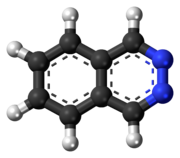 | |
 | |
| Names | |
|---|---|
| Preferred IUPAC name Phthalazine [2] | |
| Other names Benzo-orthodiazine 2,3-Benzodiazine Benzo[d]pyridazine | |
| Identifiers | |
3D model (JSmol) | |
| ChemSpider | |
| ECHA InfoCard | 100.005.422 |
PubChem CID | |
| UNII | |
CompTox Dashboard (EPA) | |
| |
| |
| Properties | |
| C8H6N2 | |
| Molar mass | 130.150 g·mol−1 |
| Appearance | Pale yellow needles |
| Melting point | 90 to 91 °C (194 to 196 °F; 363 to 364 K) |
| Boiling point | 315 to 317 °C (599 to 603 °F; 588 to 590 K) (decomposition) |
| Miscible | |
| Acidity (pKa) | 3.39 [3] |
Except where otherwise noted, data are given for materials in their standard state (at 25 °C [77 °F], 100 kPa). | |
Phthalazine, also called benzo-orthodiazine or benzopyridazine, is a heterocyclic organic compound with the molecular formula C8H6N2. It is isomeric with other naphthyridines including quinoxaline, cinnoline and quinazoline.